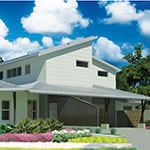Randall Moreland practices what he preaches, as evidenced by his net-zero-energy personal residence, which will seek LEED Platinum certification when completed this summer. “It’s an outflow of how my wife and I want to live our lives,” says Moreland, the owner of Miami-based Moreland Architecture + Sustainable Design. “All of those sustainable buzzwords you hear aren’t really buzzwords to us—they’re our day-to-day.”
Moreland always wanted to design his own home—“I think it’s every architect’s dream,” he says—and in considering the idea over the years, he became more and more interested in making that home sustainable. When Moreland married, that desire became a necessity. “My wife and I have congruent values in that we’re both recyclers, walkers, bikers, and transit users, so a sustainable home is a natural outgrowth of how we live our lives,” he says.
The challenge was finding that home. Moreland and his wife spent a year and a half looking for a house to buy, but when they couldn’t find anything that fit their needs, they decided to expand their search to lots with the potential for renovation or teardown. “We got lucky with this lot,” Moreland says. “It’s close to transit, walkable to the downtown core, and near the water and parks.”
The goal was to design and build a vernacular structure. “We looked back to how houses were built before the advent of air-conditioning and … took a low-tech approach,” he says of the house, which is built in the Florida cracker style and uses operable windows, vaulted ceilings, and a chimney effect augmented by reversible high-volume-low-speed (HVLS) fans to provide natural ventilation. “We can open all the windows on the bottom floor and spin the fan backwards to draw cool air up and exhaust it out a clerestory window on the second level,” Moreland says.
When finished, the 3,400-square-foot home, which the architect calls Moreland on Trapp, will have a number of other sustainable features: two dozen 270-watt photovoltaic panels with micro-inverters, two solar-thermal panels for domestic hot water, a solar-thermal pool-heating system, an 825-gallon rainwater-collection tank, and a native south Florida landscape with no turf grass and no irrigation system.
The biggest challenge, Moreland says, was using insulating concrete forms (ICFs) in a unique way. Typically, ICFs have foam exteriors with concrete poured in the middle. That creates a problem in hurricane-prone regions, however, because the foam does not take impact well and the finish can crack. Concrete provides a much better substrate to resist impact, so Moreland eliminated the foam insulation on the outside of the forms. “Nobody had done that in the city of Miami, so the building department had a lot of questions, and we had issues trying to get it built,” Moreland says.
Another hurdle was the roof, for which Moreland struggled to obtain city approval. Miami-Dade County provides notices of acceptance (NOAs) as confirmation of hurricane impact for any product used on the exterior of a home, from windows to roofing materials. A third party does rigid testing to provide the NOA, which exists for most standard assemblies. But no NOA existed for Moreland’s roofing assembly. “In Miami, standing seam metal roofs are typically attached to plywood sheathing on wood trusses, not concrete,” he says. “It’s a stronger connection, but we had to do our own third-party calculations in order to get it approved.”
When he completes it, Moreland projects that the home will use less electricity than it produces, not only raising the bar for new homes in Miami, but representing the achievement of one architect’s long-held dream.

